
CISRA Puzzle Competition 2011 - Solutions
M. Metapuzzle
The metapuzzle consists of 20 parts. Each piece contains a mini-puzzle or cryptic fragment that somehow indicates two pieces of information: The first is a number, and the second is either a location or a means of transport. In fact, the locations all turn out to be stations on the London Rail network. The numbers are sometimes implicit, but generally have a connection to some aspect of the puzzle if so. Any ambiguities should be resolvable from the realisation that each number from 1 to 20 should appear exactly once.
Solutions for the individual puzzle pieces are linked from the following table:
If we order the answers by the corresponding number, we get the following list:
- Preston Road
- Rayners Lane
- Hammersmith
- Ealing Broadway
- White City
- Taxi
- Finsbury Park
- Leicester Square
- Stockwell
- Elephant & Castle
- Marylebone
- Taxi
- Whitechapel
- West Ham
- Stratford
- Dalston Kingsland
- Walk
- Dalston Junction
- Canada Water
- Canning Town
With a little thought, and staring at rail maps, it becomes clear that an admittedly eccentric journey is being described along the London rail network, with a couple of diversions via taxi and one short walk between two nearby stations. Each other transition is achievable by a single train journey along one of the lines.
Tracing out the train journeys on the rail map yields the picture below, with the route spelling out the word "Eye". Taking the location of the journey into account, this is a reference to the London Eye, also known as the Millennium Wheel, which is the tallest Ferris wheel in Europe and a major tourist attraction of London. Returning to the railway station theme of the mini-puzzles, a bit of research (or familiarity with London geography) reveals that the nearest rail station if you want to visit the London Eye is WATERLOO, which is the answer to the metapuzzle.
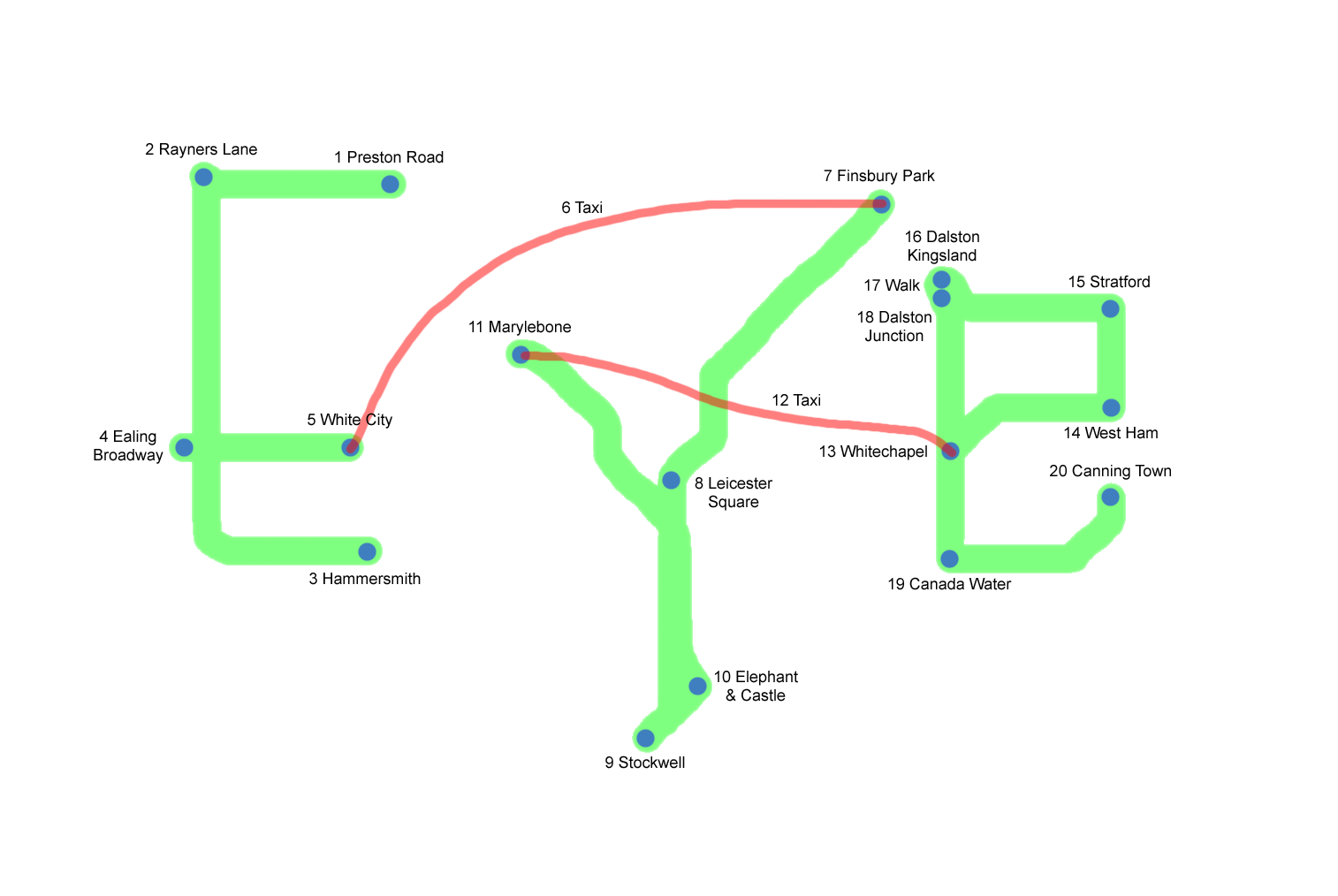
Copyright considerations prevent us from displaying the London rail map, but you may find official copies at the Transport for London website.
1A. Big Question
The puzzle text is a standard rot-13 encryption of "RIPPER MURDERS". The murders attributed to serial killer Jack the Ripper took place in or near the suburb of Whitechapel. Thus this puzzle yields 13. Whitechapel.
1B. Character References
The left side lists eight fictional characters; it is not too hard to observe a commonality between them: They have each been played by someone with "Dean" in his name. The list is:
- Superman, played by Dean Cain in Lois and Clark: The New Adventures of Superman
- Harry Cross, played by Bill Dean in Brookside
- Jim Stark, played by James Dean in Rebel Without a Cause
- Sam Harmon, played by Dean Martin in Ocean's 11 (the 1960 original)
- Francis Gremp, played by Dean Cameron in Summer School
- Brett, played by Harry Dean Stanton in Alien
- Lincoln Meyer, played by David Dean Bottrell in Boston Legal
- MacGyver, played by Richard Dean Anderson in MacGyver
It turns out that if "Dean" is elided from each actor's name then it fits exactly in the given squares.
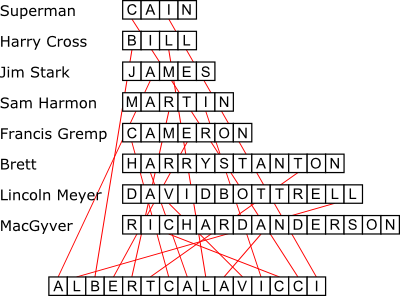
A line leads from each square in the bottom entry to a square in another entry. Filling in the bottom entry with the matching letters spells out "Albert Calavicci", a character from Quantum Leap played by Dean Stockwell. Continuing the theme, the "Dean" is dropped from this ninth actor, thus yielding 9. Stockwell.
1C. Welcome to the Machine
The text provides incomplete titles of movies or songs. The intended full names are:
- Angry and Moist: An Undead Chronicle
- Men in Black (also a song by Frank Black)
- Big Trouble in Little China
- Yellow Submarine (also a movie)
The missing words yield "Angry Men Big Yellow". These can likewise be completed to a movie and a song:
This piece thus gives 12. Taxi.
1D. Creature Feature
The picture marks out nineteen sections of Canadian national waters. Thus 19. Canada Water.
2A. Squares and Triangles
The puzzle text refers to a pub in Leyland whose street address is 1. Preston Road.
2B. Look Both Ways
Each line specifies either a letter or a number (for the last line). e.g., A-frame, F-ratio, L-plate, etc. The revealed message is "A FLY WITH NO WINGS 17". As the old children's joke goes, "What do you call a fly with no wings? A walk." Thus we get 17. Walk.
2C. Third Degree
Each line specifies a particular innings by one of 11 cricketers. After determining them all, it can be noted that each corresponds to a different position in the batting lineup. This can be used to order the players by batting position, giving:
- Charlie Hallows
- Leo O'Brien
- Umair Mir
- Bruce Edgar
- Pravin Amre
- Louis Tancred
- Allan Lamb
- Yvonne Oldfield
- Ishan Ratnayake (listed as MI Ratnayake, but his preferred name appears to be Ishan)
- Neetu David
- Gladstone Small
Reading the initials downwards yields the message "CLUB PLAYING HOME AT LORDS". The famous Lord's cricket ground is home to the Marylebone Cricket Club, and thus we get 11. Marylebone.
2D. Art Heist
The key for this part is to look at the flags of the countries/territories named: Cape Verde's flag has 10 prominent stars (one for each of the Cape Verde islands); the old flag of Siam (a former name for what is now called Thailand) has an elephant on it; and the flag of Gibraltar has a castle on it. Thus we get 10. Elephant & Castle.
3A. Togetherness
Each 3x3 square represents a number in base three. Number the columns 0, 1, 2, then read the rows downward to get the ternary representations. e.g., the first item is 022 (base 3) corresponding to the number 8, and hence to the letter "H". Continuing in this way spells out "Hammersmith", and the base three nature indicates that the associated number is 3. So this piece yields 3. Hammersmith.
3B. Puzzle Fun Placemat
After solving the crossword, the unclued across answer is seen to be "fifteen", and the first, third, and fifth rows spell out the message "Bard's birth place". Here "Bard" refers to William Shakespeare (whose works are referenced several times in the clues), who was born in Stratford-upon-Avon, indicating the answer of 15. Stratford.
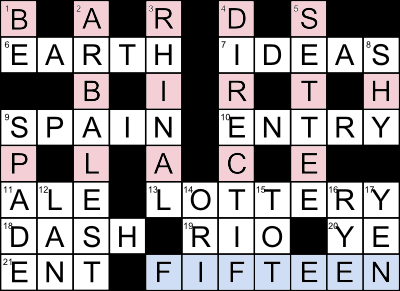
3C. Om Nom Nom
The 16 squares of the grid indicate that this is item number 16. After solving the clues, it should be realised that the answers may be placed to overlap this grid:
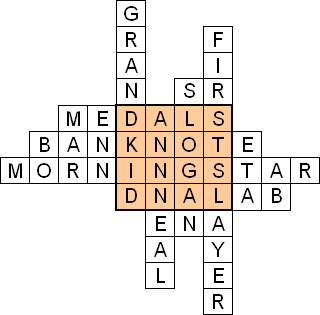
Reading the highlighted 4 by 4 grid, alternating left to right and right to left spells out the location. Combined with the number of squares in the grid, we get 16. Dalston Kingsland.
3D. Rime Royal
The text gives the names of four taxi companies. Converting the letters to numbers in standard fashion and performing the arithmetic within each name yields respective values of 20, 1, 24, and 9. Turning these back into letters spells out "taxi", confirming the answer. Performing the remaining arithmetic between the four names gives 20 + 1 - 24 + 9 = 6 as the associated number, and thus this piece yields 6. Taxi.
4A. A Typical Puzzle
The text tells us not to take irregular selections, so we should take regular ones instead. Selecting every fourth letter spells out the answer, and so we get 4. Ealing Broadway.
4B. Double Jeopardy
The sudoku is solvable by standard means, giving the following completed grid:
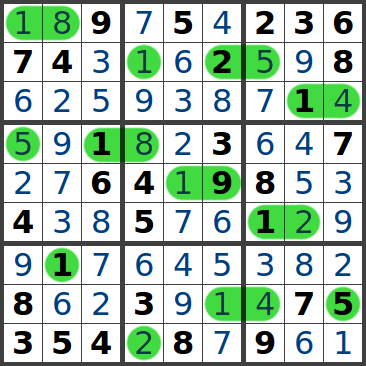
The highlighted numbers are 18, 1, 25, 14, 5, 18, 19, 12, 1, 14, 5, 2. Converting these to letters spells out "Rayners Lane", with the final "2" indicating the piece number for this puzzle. Thus: 2. Rayners Lane.
4C. Team Statistics
The text fairly straightforwardly indicates the West Ham United Football Club. Taking the first letter of each word spells "fourteen", and so this piece gives 14. West Ham.
4D. Puzzle Competition Reminder
There are 18 squares between the two grids, thus this is item number 18.
As indicated by the +/- sign in the background of the first grid, each letter should be advanced or retreated by the number in the matching square. In some cases this gives a value after Z, which is taken to be a space. The two grids that result are:

Reading from the appropriate point, combined with the number, reveals this to give 18. Dalston Junction.
5A. Latin Pipes II
A little inspiration from the layout may lead to the realisation that the desired entries are for the square root of 8. Filling in the first 65 digits of this quare root, the marked values can be converted to letters in the usual way. These anagram to "Leicester", which combines with the "Square" to give the location, and the remaining 8 is the piece number. Thus we get 8. Leicester Square.
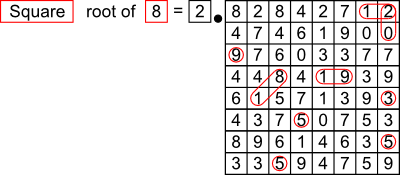
5B. Cognitive Text Fix
The signs below each character indicate a number of positions to move it, left for minus signs, right for plus signs, or omit entirely for 'x's. The message after applying the shifts is: "twenty: canning town" and thus the piece is 20. Canning Town.
5C. Caesar Salad
The resulting set is: Lisbon, Nicosia, Belgrade, Tel Aviv, and Zagreb. These five cities are all associated to the term White City and so we have 5. White City.
5D. Four-Letter Words
Placing the words in the grid yields:
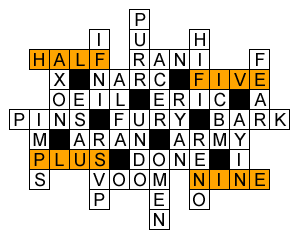
The highlighted squares spell out "HALF FIVE PLUS NINE", giving the number 7 (half of fourteen = five + nine). The middle row reads "PINS FURY BARK"; swapping the initial letters between the words in the manner of a spoonerism completes the answer: 7. Finsbury Park.